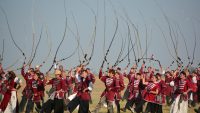Facts about Japanese Internment Camps will inform you about camps which were like prisons. Internment camp was guarded with watchtowers and surrounded by barbed wire. During World War II, many Japanese-Americans were sent to internment camps by the United States government. It was around 110,000 people, especially people had been born in the United States. Besides, the United States government forbade them to leave the internment camp. Here are ten interesting facts about Internment camps.
Facts about Japanese Internment Camps 1: Japanese-Americans before the internment
Japanese immigrants came to America for getting better life. Because they believed that cultures and races of America was the “melting pot”. They went to school, held jobs, earned money in America, then back to Japan. However, some of them wanted to start families and settle in America. Unfortunately, the government still discriminated and unfair to them although internment had been not started.
Facts about Japanese Internment Camps 2: Children
Today, many children can play together with friend and enjoy their childhood. Unfortunately, it was not happen in internment. There were 60,000 children live in the internment camp. Ironically, they could not enjoy their childhood. They could not play outside, even though there were not many facilities. That is why there were bored in the internment camp.

Facts about Japanese Internment Camps 3: Eleanor Roosevelt
Racism was a reason why Americans agreed to the internment. Besides, the Caucasians also agreed with it due to they did not want to compete with Japanese-Americans in the businesses and farming. However, Eleanor Roosevelt was the first lady who did not agree with internment. She also gave an advice to her husband not to sign it.
Facts about Japanese Internment Camps 4: Life in the Internment Camps
People lived in the wooden huts in Internment camps. They also had to share their small rooms, foods, and more. Although they got difficult situation, the families made some improvement such as schools, entertainment (theatres), and medical facilities. Whereas adults worked on the land to grow crops.

Facts about Japanese Internment Camps 5: Nisei
In the North and South America and Australia, the word Nisei is known as Japanese-Americans. It means children who born to Japanese people.
Facts about Japanese Internment Camps 6: Weather
The weather in Internment is not sure. Sometimes, it was cold in the winter and too hot in the summer. That is why their life is very uncomfortable and difficult.
Facts about Japanese Internment Camps 7: The prisoners
As we know that live in the internment is difficult. Approximately, there were 60,000 prisoners were still alive of the internment camps. Besides, the government will give award $20,000 for surviving prisoners in 1988.
Facts about Japanese Internment Camps 8: The locations of Japanese internment camps
California, Utah, Idaho, Colorado, Arkansas, Arizon, and Wyoming are locations of 10 Japanese internment camps in the United States. They belong to remote areas in seven western U.S. states.

Facts about Japanese Internment Camps 9: The U.S. Army
Eventually, the prisoners could leave the internment if they joined the U.S. Army. However, only 1,200 prisioners who took the option.
Facts about Japanese Internment Camps 10: The last Japanese internment camp
In 1945, the internment camp in the United States was closed gradually. Unfortunately, only some people who got their homes, farms, and property again after leaving the camp. Whereas the farmers left farming and start again.

We have talked facts about Japanese Internment Camps . Are you interested to read this article?



